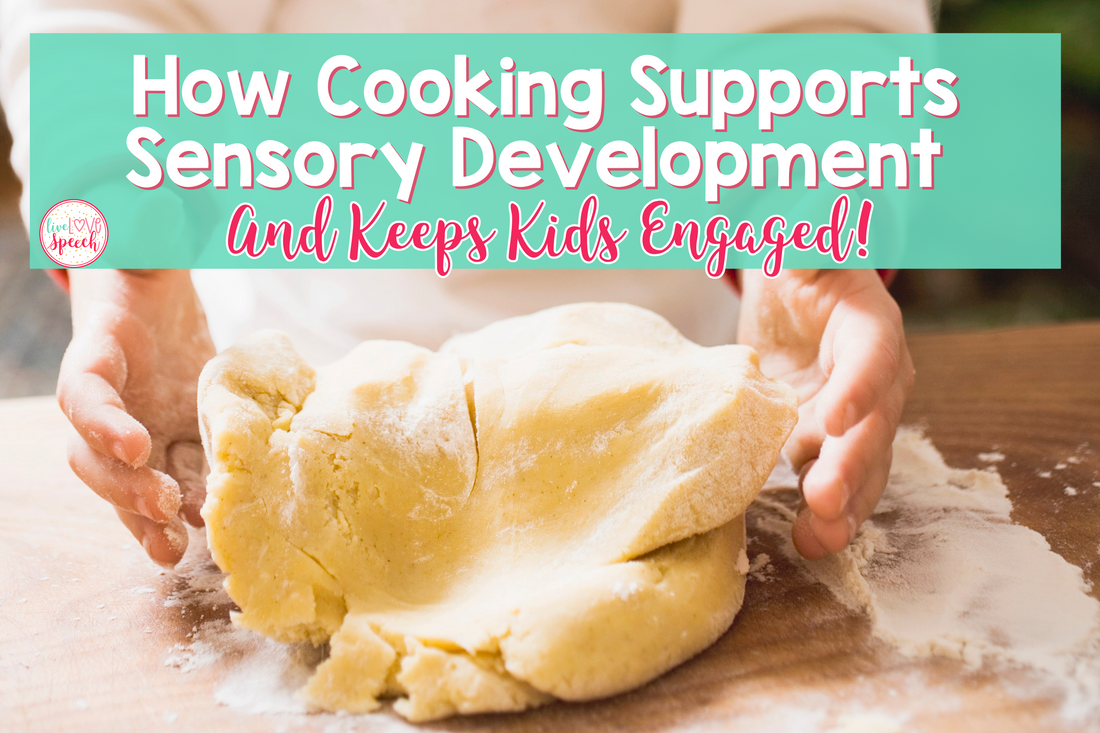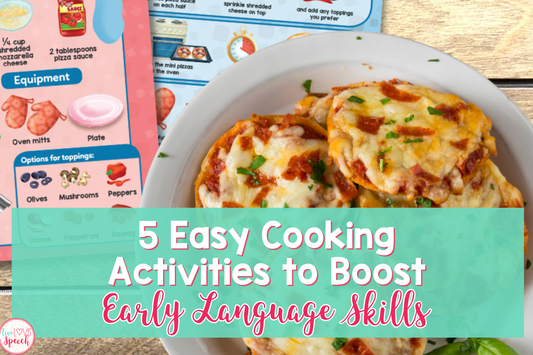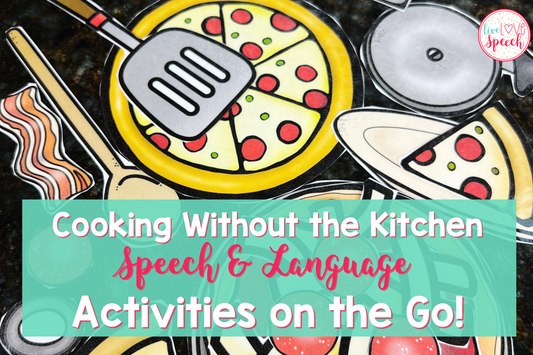
Years ago, when Landon wasn’t so big and busy, we always did sensory play.
Rice bins. Play-dough. Water beads.
If it squished, crunched, or made a mess… we were in.
But as he got older, that sensory play moved from the table to the kitchen.
Cooking is one of the best ways to support sensory development.
It’s hands-on, fun, and filled with natural ways to build language, independence, and life skills.
Let’s look at how each of the five senses plays a role.
Sensory Development in the Kitchen: Why It Works
The kitchen is the perfect space for sensory development because everything is already multi-sensory.
Kids touch, smell, taste, see, and hear, all while working toward a finished product.
There’s structure, routine, and lots of room for language growth.
Whether you’re cooking in therapy, in the classroom, or at home, it’s a powerful (and fun!) way to help children explore their senses while learning meaningful skills.
Your Five Senses
1. Touch
Touch is the first sense kids engage in during cooking.
Let them get messy:
-
Knead dough
-
Roll meatballs
-
Mix with their hands

You can also set up dry ingredient bins with flour, rice, oats, or cereal.
Use tongs, spoons, or bare hands. Let kids explore textures in their own way.
If you need a low-mess option, try sealing ingredients in a bag and letting them squish from the outside.
Touch-based activities build sensory development, fine motor skills, and vocabulary.
You can model words like sticky, soft, dry, cold, and rough as they explore.
Need a fun way to introduce this? Try the Watermelon Dough Visual Recipe Freebie.
It’s a simple, hands-on activity that combines sensory play with step-by-step visuals.
Perfect for therapy or home, and it smells amazing too!
2. Taste
Taste doesn’t have to be stressful.
It can be a gentle, safe way to expand food preferences and build confidence.
Try offering:
-
A sprinkle of sugar or cinnamon
-
A small bite of fruit
-
A sample of the finished recipe
Let kids compare what’s sweet, sour, or salty.
Talk about what they like and don’t like.
These small tasting moments are perfect for encouraging expressive language, decision-making, and confidence.
Taste supports sensory development and introduces new vocabulary through real experiences.
3. Smell
Smell is powerful. It connects to memory and emotion, and it’s a great way to engage kids who are hesitant to touch or taste.
Use aromatic ingredients like:
-
Vanilla
-
Cinnamon
-
Lemon
-
Garlic
-
Herbs

Let kids sniff and describe what they smell. You can even set up a scent guessing game using safe kitchen ingredients.
Want an easy way to bring in these scents? Try a simple recipe like cinnamon apples or garlic bread.
The bold smells will grab their attention and open the door for lots of descriptive language and sensory development.
Smell-based activities support sensory development and build descriptive language in a natural way.
4. Sight
The kitchen is full of visual learning opportunities.
Encourage kids to:
-
Sort ingredients by color
-
Compare smooth vs. bumpy textures
-
Observe changes in food as it cooks
Ask questions like:
“What color is it now?”
“Did the batter rise?”
“How did the texture change?”
Visuals help kids follow steps, anticipate changes, and stay engaged.
That’s why I created my Visual Recipe Cards.
Each recipe includes real photos, simple icons, and step-by-step directions perfect for supporting young learners, picky eaters, and kids working on life skills.
They're a great way to promote independence, sequencing, and language development, all while keeping the activity visually structured.
Whether you're cooking in the classroom, in therapy, or at home, these cards make it easy to tie in sensory development while keeping kids focused and involved.
Need quick ideas to get started?
These Kids’ Cooking Activities in 30 Minutes or Less are perfect for building sensory development into your routine, without spending hours in the kitchen.
Sight helps with observation, sequencing, and visual discrimination, key parts of sensory development.
5. Sound
The kitchen can be noisy, but in a good way.
Listen for:
-
The sizzle of a pan
-
The crunch of chopped veggies
-
The hum of a blender
Use these sounds to talk about safety, readiness, and process.
-
“That beep means it’s ready.”
-
“It’s crackling now—it’s cooking!”
-
“Crunchy foods sound different than soft ones.”
Hearing and identifying kitchen sounds support auditory processing and strengthen sensory development.
Cooking Time = Sensory Time + Learning
When kids help in the kitchen, they’re doing so much more than making food.
They’re learning life skills.
They’re building confidence.
They’re strengthening sensory development and language.
Want tools that make it easy?
Try my Visual Recipe Cards!
Want even more sensory-friendly cooking ideas?
Check out this blog post with hands-on activities that support sensory development from start to finish:
5 Sensory Cooking Activities for Kids
The kitchen is ready.
The ingredients are waiting.
Let’s get cooking and learning with all five senses.
You've got this, and I’m here to help make it visual, functional, and FUN.








